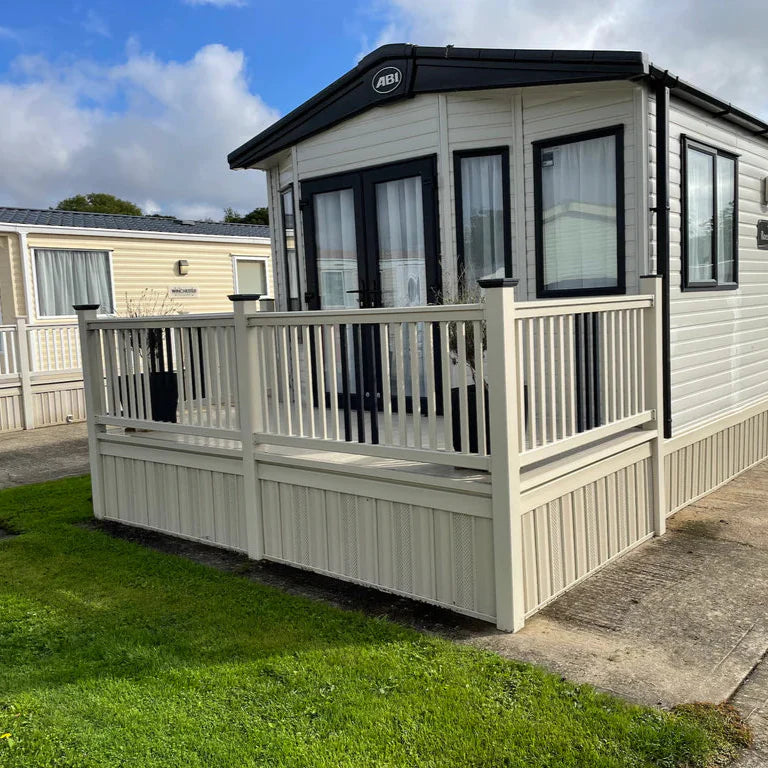Decking Kit Installation Guide
Posted by Greg Parkins on

You've just purchased your decking kit and can't wait to get your new feature installed and ready for action.
Our guide on how to install your new self build decking kit will tell you everything you need to know when it comes to fitting, finishing and taking care of your new outside space.
What you'll need:
- Safety gloves
- Safety goggles
- Ear protection
- Pencil
- Tape measure
- Axle stands
- String line
- Spirit level
- Drill/Driver
- Screwdriver
- Fine tooth wood saw
- Power saw
- Hacksaw
- Appropriate screws (provided)
*N.B. These instructions are intended as a guide only as all installations vary. All Self Build Deck Kits should be installed by competent persons Deck Supermarket Limited can not be held responsible for mistakes or injury that happen while using this guide.
*All heights and Building Regulations should be checked with Local Authority prior to installing and correct codes of practice followed by the installer.
Setting the frame height and distance
Measure from bottom of door to bottom of your home, halve this measurement, and deduct the thickness of your chosen deck board. Make a note of this number.

Cut two block of timber to the measurement you made a note of, making sure they're square.

Then cut two slightly longer lengths as per the the image to form an 'L' shape and screw these together.

Building the frames
You will receive a copy of the frame plan of your deck with your kit. The plan will show the size and position of each frame, and each frame will be tabled accordingly.
The outer frame and joists are already cut to size, with the outer held together at each corner with heavy duty metal corner brackets. These in turn are attached to the timber by 8 x 40mm wood screws.

Your outer frame should be constructed on a flat surface if possible. It should be screwed together equally so there are no lips to create high spots.
Once the outer frame is constructed and square, the joists can be added. These should be spaced equally and screwed at each end using the provided 70mm wood screws.
There will be timber provided that can be used for a centre line of noggins to hold the joists straight. These should be staggered slightly to allow you to screw through the joist into each noggin at either end.
The images below illustrate completed frames:
Levelling the frames


Setting the frame fall
 Setting your post heights
Setting your post heights
Because the ground is not always level, you may need to trim each post sleeve to height.
This is done by offering a tall post sleeve to its placement. Measure from the top of the frame, mark the post at the following heights above the frame, and cut to length.
- 920mm from frame to top of post if using 695mm pickets
- 1020mm from frame to top of post if using 795mm pickets
- 1120mm from frame to top of post if using 895mm pickets
To save time, mark your desired height onto a length of straight timber and use this as a staff to mark each post at the same height above the frame.
The posts can now be attached
 Add gate post to cleat if required and your support posts
Add gate post to cleat if required and your support posts
 Next add your Super Rail fascia
Next add your Super Rail fascia
You're now ready to add your Super Rail fascia. Use a fine tooth saw for this job, cutting one end with a slight back mitre to achieve a perfect fit. Then, screw through the frames from behind. Always measure twice and cut once!

Your frame should now be complete

Time to add your steps if required
Measure from the top of the frame to the floor and divide this measurement by three for a 2-tread step assembly or by four for a 3-tread step assembly.

Next, mark the posts using a square and pencil. For example, if your total measurement is 600mm and it's a 2-tread assembly, then the post will be marked at 200mm and 400mm from the ground.
Now place the top of the U-bracket next to your mark and attach each bracket to the post using 4 x 32mm stainless screws.

Transfer the bracket heights across to the outer posts using a spirit level and mark with a pencil. This will keep the step treads level, even if the floor is not.
Attach the remaining four U-brackets in the same way as before using 4 x 32mm stainless screws per bracket.
You can now attach your pre-assembled step trays, which will slot into the U-brackets. Once fitted, you'll need to drill a small pilot hole through the side of each U-bracket and secure each step tray with a 25mm stainless screw (marked by the yellow arrows).
Step tread support posts
The step support posts should now be cut to size and attached with 2 x 25mm stainless screws through the pre-drilled holes.

The posts should be cut very slightly over height to make sure they fully support the step tread and fully touch the ground - but not so much that your step is bowed.
Adding the bottom step rail
You can now attach the bottom diagonal step rails. These will need cutting to length - you should cut the deck side first.

Slide over a stair rail bracket and hold against the deck/taller post. You can then let the rail find its natural angle in the bracket, mark, and cut the other end to length. Attach the brackets to the posts using 4 x 32mm stainless screws.
The brackets again will need piloting through the side, as per the image, and the rails securing with a 32mm stainless screw in each bracket.
Do not attach the top rails at this point.
Cut starter trim to size and attach with 40mm wood screws
We usually start at the step end of the deck, and the starter should be cut tight between the posts. Allow an overhang past the fascia of approximately 20mm, or 20mm back from the front of the post to allow water to drip away naturally.
This can now be attached to the frames with the 40mm screws level with the joist centres.

You're now ready to add your first deck board
The first deck board can now be offered. It should be placed tongue side towards the starter trim, and the outer end of the board should be approximately 22mm from the outer post face to allow for the u-channel.

You can now use a square and pencil to mark the boards around each post. Cut out carefully with a jigsaw for ease, and take your time - it's important to be accurate.
After you've cut the post cut outs, the board can be placed into the groove of the starter trim and screwed to frame at the joist centres using the 40mm wood screws provided.
Add the other boards to complete
You can now work your way back from first board, screwing at each end and joist centre and cutting around any outer posts as required.

When you reach the last board, it may be an exact fit (if you are very lucky). More than likely you'll need to carefully trim the board along its length with either a jigsaw or circular saw - make sure you use the correct safety equipment when doing so.
Attaching the U-Channel
The U-channel can now be marked and cut to size - again this should be very slightly over size. The trim is made to be a snug fit and will need easing over the boards, then knocking on with a soft mallet.

The U-channel should not be screwed in place as it acts as a natural gutter, taking any rainwater away and allowing it to run down the posts. Over time, it may collect a little debris or grit. This can be removed annually if required, and the channel can be cleaned with soapy water.
Attaching your handrails
First check the steel reinforcements are in the handrails as per the image. Set the height of the bottom rail up to 100mm max from the deck and attach the bottom rail brackets to the two outer posts of the run using 4 x 32mm stainless screws per bracket.

Now, use a string line strung tightly between the two outer brackets to make sure that your run of handrail will be level all the way through.

Mark where the line touches the centre posts, transfer, and mark by using a square and pencil. You can now attach your bottom rail brackets to your bottom rails and attach as before using 4 x 32mm screws per bracket, making sure the routed holes are facing upwards.

You can now use a spirit level to set your end bottom rails level. Because of the fall on the deck, the gap between the bottom rail and deck will not be exactly parallel, but the rails will be level.
Adding pickets and handrails
You can now go around and add your pickets to the bottom rails - then you're ready to add your handrails.

First, check the steel reinforcements are inserted. Then, sit the handrails onto the pickets. This step is helped by slightly angling the top rail and inserting the pickets one at a time, starting at one end and working to the other.

You can now add the top rail brackets, centre your rails to the post, and attach using 4 x 32mm stainless screws per bracket.
Attaching handrails for the steps and the caps
Now your handrail level is set, you can add the step rails by fixing them to the same height as your other handrails - in the same way that you fixed the lower step rails.

Then, you can go round and silicon your caps in place. Please note that a standard cap will be used on the posts closest to the caravan to prevent rubbing.
Hanging the gate
You can now get started on installing your gate if required. First, turn your gate upside down and drill 3 x 5mm drain holes.

Next, line the top of your gate with the top of your handrail and screw the hinges in place. Finally, attach your latch parts and check it operates properly.
End by cleaning off your new decking with a soft cloth. After this, your install is complete

Taking care of your deck
We want you to enjoy your deck purchase for many years to come and a few simple steps will help this happen.
Cleaning should only be done with mild soapy water, rinsed off with clean water.
Under no circumstances should harsh or abrasive chemicals be used to clean any part of the deck. We can advise you if more than soapy water is required, and tell you the correct products to use.
We would also advise that mats are not used on the deck as although our products are fully UV tested and warrantied, discolouration may occur if items like mats are left in one place for a long period.
For a more in-depth guide on maintenance, check out our guides on how to treat decking and how to care for uPVC decking.
We hope you enjoy your purchase!
If you have any questions about installing your decking kit, get in touch with our team and we’ll be happy to help.

